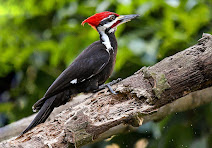THE WOODPECKER BIRD
The woodpecker bird is a small to medium-sized bird that is known for its distinctive behavior of tapping its beak against trees to create holes. There are over 200 different species of woodpeckers found all over the world, and they come in a variety of colors and sizes.
Physical Appearance: Most woodpeckers have a pointed beak that is long and chisel-like, which they use to peck at trees to create holes for nesting and foraging. They also have a strong, muscular neck that allows them to withstand the force of their pecking. The size and shape of the beak can vary depending on the species, with some having a shorter, wider beak for digging into bark and others having a longer, thinner beak for probing into crevices in trees. They have zygodactyl feet, which means they have two toes pointing forward and two toes pointing backward, allowing them to cling to vertical surfaces such as tree trunks. They have sharp claws that are used for climbing and clinging onto tree bark. Their plumage can range from bright and colorful to dull and brown, with patterns that include stripes, spots, and patches.
Click here you will get to watch youtube video of Woodpecker
Habitat:
Woodpeckers can be found in a variety of habitats, including forests, woodlands, parks, and gardens. They prefer areas with mature trees, as this provides them with plenty of opportunities to create holes for nesting and foraging. Some species of woodpeckers are migratory, traveling long distances to find suitable breeding and feeding grounds.
Diet: Woodpeckers are omnivores, feeding on a variety of insects, fruits, nuts, and seeds. They use their beak to peck away at tree bark to find insects such as beetles, ants, and termites, which they can eat or feed to their young. Some species of woodpeckers also eat fruit, nuts, and seeds, which they can easily extract from trees. They have a long, sticky tongue that they can use to capture insects deep within crevices in trees.
Behavior: Woodpeckers are known for their drumming behavior, which they use to communicate with other woodpeckers and to attract mates. They also use their drumming behavior to locate insects within trees. When a woodpecker drums, it creates a loud, rhythmic sound that can be heard from a distance. They are also known for their territorial behavior, defending their nesting sites and feeding grounds from other birds.
Reproduction: Woodpeckers are monogamous, and they mate for life. They typically nest in tree cavities that they have created themselves, using their beak to carve out a hole. They lay a clutch of eggs, with the number of eggs varying depending on the species. Both parents take turns incubating the eggs, which hatch after a few weeks. The chicks are fed regurgitated insects by both parents until they are old enough to leave the nest.
Conservation Status: While some species of woodpeckers are abundant, others are threatened or endangered due to habitat loss and degradation. Some species of woodpeckers are also hunted for their feathers and meat. Conservation efforts are underway to protect woodpecker habitats and to raise awareness about the importance of these birds in maintaining healthy ecosystems.
In conclusion, woodpeckers are fascinating birds with unique adaptations that enable them to thrive in a variety of habitats. Their distinctive drumming behavior, strong beaks, and zygodactyl feet make them easy to identify in the wild. With their important role in maintaining healthy ecosystems, it is important to protect and conserve woodpecker populations around the world.


